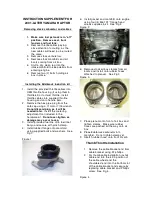
8-50
Maintenance
Temperature -A, B & C
The temperature grades are A (the
highest), B and C representing the
tire’s resistance to the generation of
heat and its ability to dissipate heat
when tested under controlled condi-
tions on a specified indoor laboratory
test wheel.
Sustained high temperature can
cause the material of the tire to de-
generate and reduce tire life, and ex-
cessive temperature can lead to sud-
den tire failure. Grades B and A
represent higher levels of perfor-
mance on the laboratory test wheel
than the minimum required by law.
WARNING
The temperature grade for this tire
is established for a tire that is
properly inflated and not overload-
ed. Excessive speed, under-infla-
tion, over-inflation, or excessive
loading, either separately or in
combination, can cause heat build-
up and possible sudden tire fail-
ure. This may cause loss of vehicle
control resulting in an accident.
Low aspect ratio tires
Low aspect ratio tires, the aspect ra-
tio is lower than 50, are provided for
sporty looks.
Because low aspect ratio tires are op-
timized for handling and braking, their
sidewall is a little stiffer than a stan-
dard tire. Also low aspect ratio tires
tend to be wider and consequently
have a greater contact patch with the
road surface. In some instances they
may generate more road noise com-
pared with standard tires.
CAUTION
Because the sidewall of a low as-
pect ratio tire is shorter than a
standard tire, the rim of the wheel
and the tire itself is more easily
susceptible to damage. Use cau-
tion when driving and follow the
guidelines below to help minimize
damage to the wheel and tire:
• When driving on a rough road or
driving off a road, be careful not
to damage the tires and wheels.
After driving, inspect the tires
and wheels.
• When passing over a pothole,
speed bump, manhole, or curb
stone, drive the vehicle slowly
so as not to damage the tires
and wheels.
• If the tire is subjected to a se-
vere impact, we recommend you
have the tire and wheel inspect-
ed by an authorized HYUNDAI
dealer.
• Inspect the tire condition and
pressure every 3,000 km (1,800
miles) to prevent tire damage.
• It is not easy to recognize tire
damage with your own eyes. But
if there is the slightest hint of
tire damage, have the tire
checked or replaced because
the tire damage may cause air
leakage from the tire.
• If the tire is damaged by driving
on a rough road, off road, pot-
hole, manhole, or curb stone, it
will not be covered by the war-
ranty.
















































